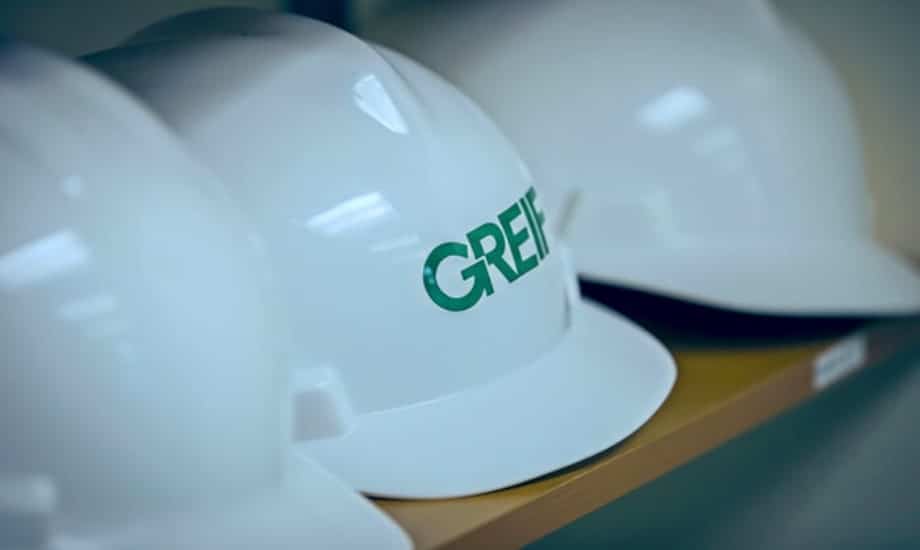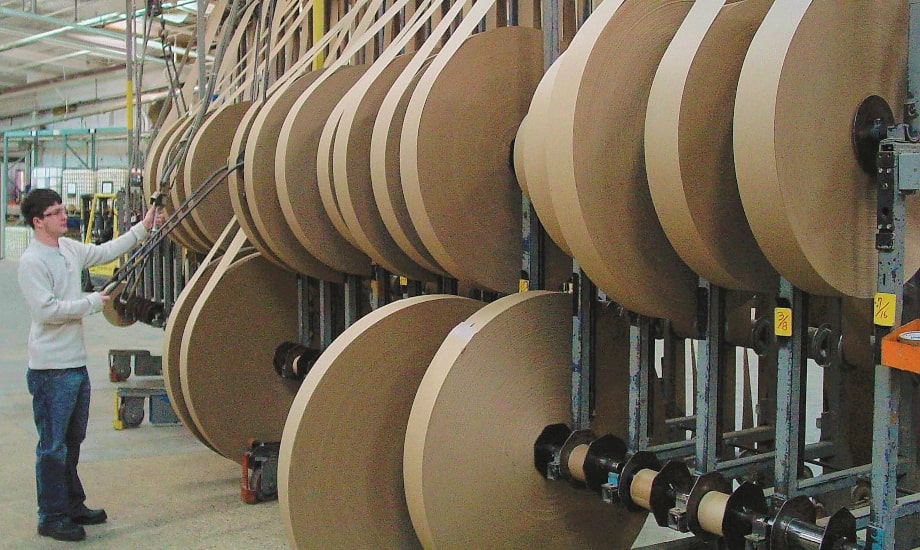Por que a água é importante
Como uma empresa global de fabricação, a Greif tem a responsabilidade de minimizar nosso uso de água e melhorar a qualidade da água, particularmente em nossas operações mais intensivas em água. A gestão responsável da água reduz nossa demanda por água, pois a escassez de água e os custos da água estão aumentando, e garante que a descarga de água de nossas instalações seja tratada e segura para proteger a saúde das comunidades nas quais operamos. Nossas práticas de gestão de água simultaneamente alcançam esses objetivos, ao mesmo tempo em que criam eficiências operacionais e minimizam o risco regulatório.
Governança
Apenas 1%
total de água consumida em regiões com alto estresse hídrico de base
Nossos esforços na qualidade da água já nos permitiram atingir nossa meta de redução de 10% até 2025.
A Greif monitora os Indicadores-chave de desempenho (KPIs) para garantir o tratamento adequado de nossas águas residuais. Se ocorrer um incidente de tratamento, o gerente da instalação observará uma mudança nesses KPIs, o que inicia uma investigação para determinar a causa raiz e resolver o problema. Quando necessário, a Greif contrata especialistas terceirizados para dar suporte às nossas investigações. Por exemplo, em 2020, a fábrica Tama da Greif apresentou alta demanda bioquímica de oxigênio (DBO) e concentrações de nitrogênio. A Greif contratou um terceiro para conduzir uma inspeção no local e recomendar ações corretivas. Com base em suas recomendações, aumentamos a adição de nutrientes, instituímos testes analíticos aprimorados para monitorar os níveis de nutrientes e introduzimos testes de demanda química de oxigênio (DQO) para receber feedback mais rápido sobre possíveis problemas.
Embora o impacto hídrico da Greif seja predominantemente em nossas operações de PPS, tomamos medidas para reduzir o uso de água em todas as nossas operações, particularmente em regiões com escassez de água na América Latina, África e Oriente Médio. Nessas instalações, e em todas as nossas operações, reduzimos a pressão da água onde ela é maior do que o necessário, substituímos válvulas com vazamento e coletamos e usamos água da chuva quando possível. Nossa unidade de Embalagem Industrial Global em Riad, Arábia Saudita, implementou muitas dessas medidas em um esforço para reduzir e reciclar suas águas residuais, resultando em uma redução de 32% nos resíduos para aterro de suas instalações. Consulte nossa Desperdício página para mais informações sobre suas conquistas.
Em 2021, desenvolveremos painéis de dados ambientais padrão em todas as nossas fábricas para entender e gerenciar melhor os dados de água e efluentes, bem como de energia, e continuaremos trabalhando para identificar oportunidades de eficiência hídrica.
Metas e Progresso
Em 2017, a Greif anunciou uma meta para 2020 de redução de 10% em quilogramas de demanda bioquímica de oxigênio (DBO) por tonelada métrica de produção, de uma linha de base de 2014 de 1,47, nas fábricas legadas da Greif. Nosso processo de materialidade de 2017 levou à criação de novas metas para 2025 e à reafirmação de nossa meta de DBO como uma meta para 2025. Além disso, em 2021, planejamos criar metas e alvos para 2030 em linha com a American Forest and Paper Association.
Em 2018, reavaliamos nossos dados históricos de uso de água e BOD para confirmar nossa linha de base e suposições para dar suporte à melhoria contínua relacionada à água. Por meio desse processo, reafirmamos nossa linha de base de BOD de 2014 para 1,40.
Meta 2025: Reduzir a DBO descarregada em quilogramas em 10 por cento por tonelada métrica de produção combinada das usinas de Riverville e Massillon usando a linha de base reajustada de 2014 até o final do ano fiscal de 2025.
Progresso: Desde 2017, reduzimos a DBO por tonelada métrica de produção em 71,8 por cento em nossas antigas fábricas de papelão para contêineres Greif. Nosso progresso significativo em relação à nossa meta de DBO foi possibilitado pela instalação de uma estação de tratamento de águas residuais em nossa fábrica Massillon. Concluído em julho de 2017, o projeto levou a melhorias modestas em 2017 e superou em muito as expectativas em 2018. Esses benefícios continuaram a ser percebidos em 2020.
Em 2021, continuaremos a monitorar nosso progresso na redução de BOD enquanto controlamos o uso específico de água em nossos moinhos e reavaliamos nossas metas para incluir nossos moinhos Greif legados e moinhos Caraustar que agora fazem parte de nossa organização. Além disso, em 2021, anunciaremos novas metas de redução de água para nossos moinhos.
Dados de desempenho
ÁGUA*
|
|
AF 2016 |
AF 2017 |
AF 2018 |
AF 2019 |
AF 2020 |
|---|---|---|---|---|---|
|
Retirada de água (milhares de metros cúbicos)* |
8,420.2 |
9,666.3 |
9,360.8 |
13,864.4 |
12,936.6 |
|
Água de superfície |
- |
9,242.7 |
8,630.0 |
10,266.8 |
10,132.0 |
|
Água subterrânea |
- |
423.6 |
730.7 |
3,597.6 |
2,804.6 |
|
Água da chuva |
- | - | - | - | - |
|
Águas residuais |
- | - | - | - | - |
|
Água Municipal† |
- | - | - | - | - |
|
Descarga de águas residuais (milhares de metros cúbicos)** |
7,961.4 |
8,983.2 |
9,316.2 |
12,403.92 |
11,935.1 |
|
Rio James |
- |
8,788.8 |
8,907.1 |
7,949.5 |
8,375.0 |
|
Cidade de Massillon |
- |
191.6 |
407.1 |
424.0 |
355.8 |
|
Rio Tuscarawas |
- |
2.8 |
2.0 |
2.5 |
8.8 |
|
Riacho Sweetwater^ |
- |
- |
- |
0.0 |
0.0 |
|
ETAR do Condado de Cobb^ |
- |
- |
- |
844.9 |
855.0 |
|
Distrito de esgoto metropolitano de Cincinnati^^ |
- |
- |
- |
37.6 |
40.6 |
|
Distrito de esgoto metropolitano de Milwaukee^^ |
- |
- |
- |
349.0 |
335.9 |
|
Distrito de Saneamento do Condado de Los Angeles WWTF^^ |
- |
- |
- |
196.8 |
189.1 |
|
Riacho de três milhas^ |
- |
- |
- |
0.0 |
- |
|
Vila de Baltimore WWTF** |
- |
- |
- |
0.0 |
6.1 |
|
Riacho Paw Paw do ramo oeste** |
- |
- |
- |
697.1 |
581.4 |
|
ETAR Regional de San José-Santa Clara^^ |
- |
- |
- |
288.1 |
334.2 |
|
ETAR de Tacoma Central^^ |
- |
- |
- |
6.9 |
8.5 |
|
Estação de Tratamento de Efluentes da Cidade de Fitchburg |
- |
- |
- |
322.6 |
309.0 |
|
Rio Iowa** |
- |
- |
- |
291.8 |
364.9 |
|
Lago Cereja** |
- |
- |
- |
597.8 |
550.4 |
|
Tributário de Iowa** |
- |
- |
- |
58.0 |
78.6 |
|
Demanda bioquímica de oxigênio (milhares de kg) |
1,050.4 |
890.4 |
204.2 |
3,508.3 |
3,457.1 |
|
Sólidos Suspensos Totais (kg) |
546,857 |
465,098 |
349,003 |
1,224,442 |
1,045,928 |
|
Fósforo (kg) |
5,728 |
4,991 |
6,617 | 4,708 | 4,445 |
|
Produção (MT) |
665,000 |
690,000 |
713,336 |
1,729,062 |
1,661,228 |
|
Taxa de consumo (m3/MT) |
12.7 |
14.0 |
13.1 |
8.02 |
7.79 |
Notas:
- Os dados de 2015 a 2018 são das duas fábricas de papel da Greif, uma das quais está localizada em Riverville, Virgínia, e a outra em Massillon, Ohio. Historicamente, essas duas fábricas de papel foram responsáveis por mais de 90% da pegada hídrica global da Greif. Elas extraem do Rio James e de poços de água no local, respectivamente. Os dados de 2019 incluem 12 antigas fábricas Caraustar que foram adquiridas e integradas em 2019. Todos os dados de 2019 são dados do ano inteiro. A qualidade das águas residuais descarregadas de nossas fábricas atende aos requisitos de licença. Nenhuma água descarregada foi usada por outra organização. WWTP = Estação de Tratamento de Águas Residuais.
- Os dados do ano fiscal de 2019 incluem a ETAR Mobile Wright Smith, que foi fechada em 2020 e foi recalculada para contabilizar adequadamente a descarga do West Branch Paw Paw Creek do ano fiscal de 2019.
**Tratado com clarificação primária, clarificação secundária e aeração antes da descarga direta.
^ Tratado com pré-tratamento de águas residuais, incluindo remoção de DBO solúvel.
^^ Tratado com pré-tratamento de águas residuais apenas com sólidos.
† Atualmente, a Greif não monitora a retirada de água municipal.
|
uso de água em regiões com Estresse Hídrico de Base Alto ou Extremamente Alto* |
AF 2020 |
|---|---|
|
Captação de Água (Milhares de metros cúbicos) |
170.4 |
|
Porcentagem de retirada total de água |
1% |
|
Água consumida (milhares de metros cúbicos) |
162.7 |
|
Porcentagem de água total consumida |
1% |
Melhorando Nossas Águas Residuais
Em 2017, a fábrica de Greif em Massillon, Ohio, concluiu a construção de uma estação de tratamento de água para reduzir significativamente a demanda biológica de oxigênio (DBO) da água de descarga da planta antes de ser devolvida à estação de tratamento municipal. Altos níveis de DBO promovem o crescimento de bactérias, liberam odores e devem ser controlados usando produtos químicos. Desde a instalação da estação de tratamento, reduzimos a DBO descarregada no sistema municipal em mais de 96%, contribuindo para nossa meta de redução de DBO para 2025. Isso também eliminou vários produtos químicos que eram necessários anteriormente para controlar bactérias.

Redução de água em nossa fábrica em Baltimore, Ohio
Em 2020, a fábrica da Greif em Baltimore, Ohio, fez a transição da descarga direta de águas residuais tratadas para um riacho local para a descarga de águas residuais pré-tratadas para uma estação de tratamento de água local que usa um sistema de tratamento de membrana de última geração para tratar ainda mais a água. Essa mudança reduziu a descarga geral de água e apoiou o retorno de água mais limpa para a comunidade. A Greif se envolveu com governos locais e estaduais ao longo de vários anos para projetar e aprovar o projeto, que foi aprovado em 2019 e concluído em outubro de 2020. O projeto reduzirá o consumo de água em 550.000 m3 por ano. A comunidade se beneficia de uma água de superfície mais limpa, já que várias toneladas por ano de demanda biológica de oxigênio e sólidos suspensos totais também foram removidos dos riachos locais por causa dessa transição.

DESTAQUES DE SUSTENTABILIDADE
Apenas 1%
Total de água consumida em regiões com alto estresse hídrico de base
Nossos esforços na qualidade da água já nos permitiram atingir nossa meta de redução de 10% até 2025.


